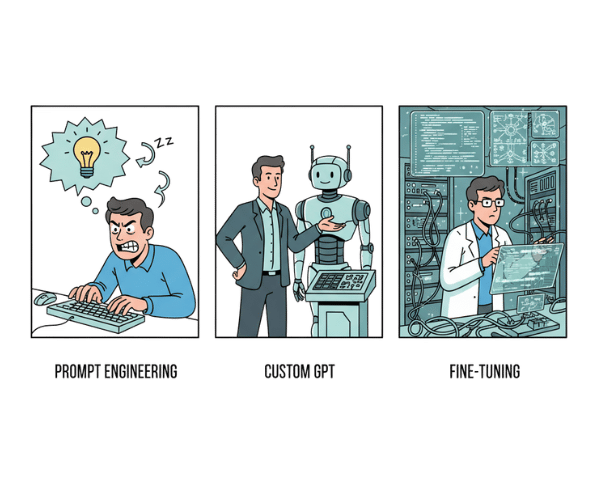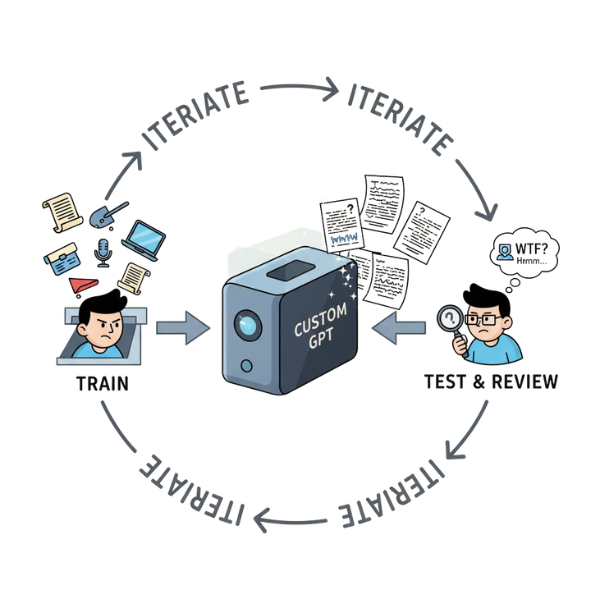5 Steps to Train a Custom GPT That Sounds Exactly Like You
GROWTHSAAS
11/11/20255 min read


Key Takeaways
A Custom GPT can be trained to replicate your unique tone, phrasing, and communication style – ideal for founders, marketers, and teams scaling authentic content.
Start with a Master Prompt, your AI “voice guide.”
Use a mix of written and spoken data (emails, posts, transcripts) for realistic tone training.
Choose the right method – Prompt Engineering, Custom GPT, or Fine-Tuning – based on your goals and resources.
Add a Memory Vault or RAG system to keep your GPT aware of your latest projects and data.
Test outputs via real-world roleplays and tone sharpening before deployment.
Always prioritise privacy and governance when handling internal or client-based data.
The Problem: AI Speeds You Up – But It Can Dilute Your Voice
AI can write faster than any human – but most of what it writes doesn’t sound like you.
For founders and marketing teams, that’s not a small issue. It’s a brand identity problem.
Your tone builds trust. When it’s gone, so is authenticity – and your brand starts to sound like everyone else.
That’s why custom-trained GPTs are becoming the go-to growth tool. They help you create content quickly without losing your voice.
At BriskFab, we help founders and teams do exactly this – using AI to scale their content while keeping every word aligned with their unique style and tone.


Step 1: Define Your Voice Before You Train Anything
Before you upload data, clarify what your voice means.
Ask yourself:
How do I sound when explaining something to my team?
Do I lean more toward storytelling or straight-to-the-point?
Is my default tone witty, analytical, or conversational?
Then draft a Voice Brief:
3–5 adjectives describing your tone (e.g., direct, pragmatic, witty)
Common phrases you use – and ones you avoid
Your audience type and communication goals
Build Your Master Prompt
Think of the Master Prompt as your AI’s compass.
“Help me create a Master Prompt for my writing voice. Ask questions about my tone, audience, favourite expressions, and values. Summarise it into a one-page profile.”
Save that as a PDF. Upload it whenever you use ChatGPT or your custom assistant so the model responds in your style – not the generic internet’s voice.


Step 2: Gather and Prepare Your Data – Your Words Are the Training Fuel
Your GPT only sounds as good as the data you feed it.
Collect 25–200 pieces of content that reflect your natural tone:
Blog posts, newsletters, or press releases
Client proposals or onboarding documents
LinkedIn posts or essays
Emails that "sound like you"
Then clean the dataset:
Remove outdated or irrelevant pieces
Convert everything to plain text
Maintain consistent formatting for better processing


Include Voice Transcripts
Many founders express themselves more effectively when speaking than when writing.
Record a short voice note, podcast segment, or Zoom call. Transcribe it. These spoken samples capture pacing, phrasing, and informal flows – data that most text-only sets miss.
Step 3: Choose Your Training Method
Different goals call for different levels of customisation.


1. Prompt Engineering
Best for fast tasks: provide tone instructions + sample references each time.
Fast to implement, but repetitive.
2. Custom GPTs
Ideal for ongoing usage: upload your Voice Brief and examples into the GPT builder.
Reusable and scalable, though the dataset size is often limited.
3. Fine-Tuning (LoRA / QLoRA)
For advanced users or teams managing multiple voices. Use the OpenAI Fine-Tuning API or Hugging Face for a deep voice match.
Add a Memory Vault
Combine your voice training with a retrieval layer: a private “Memory Vault” where current projects, briefs, and content live. Then your GPT stays relevant and contextual.


Step 4: Train, Test, and Refine
Start small: train with 25–50 examples, generate outputs, then review.
Evaluate outputs on:
Tone accuracy: Does it sound like you?
Clarity: Is it structured how you write?
Authenticity: Does it reflect your thinking rather than generic AI?
Role-play and Message Tests
Test your GPT in real-world contexts:
Play out a client conversation.
Rewrite a sharp message into one that’s firm but kind.
Summarise a blog in your exact tone.
Example prompt:
Rewrite this note to be direct yet polite – in my tone and phrasing.
Rinse, iterate until 80%+ of outputs feel like you on a good day.
Step 5: Deploy Safely – and Keep It Updated
Protect Your Data
Never upload sensitive or client materials. Track your training data, and limit access to your team. Governance matters.
If you’re an enterprise, explore on-premise GPT deployments or private API setups to keep your data fully secure.
Keep It Fresh
Your voice evolves – your GPT should too. Retrain or fine-tune every 3-6 months using new content and transcripts.
Combine With Retrieval
Link your GPT to private databases (Notion, Google Drive, vector DB) so it stays current with projects, product updates, and campaigns.
Real-world Example
A SaaS founder trained their GPT on blog posts, sales decks, and email archives. It now drafts ~80% of outbound content, saving over 15 hours per week while staying true to their founder's voice.
We at BriskFab help founders and B2B marketing teams achieve this kind of scale – creating AI-powered content engines that stay authentic, efficient, and on-brand. From GPT customization to workflow automation, our approach ensures your voice drives your growth, not the algorithm’s.


Prompt Toolbox – Try These Today
1. Master Prompt Builder
Help me create a Master Prompt that defines my writing voice. Ask about tone, audience, and key phrases. Output a one-page summary.
2. Transcript-to-Text Sample Generator
Here’s a transcript of my five-minute talk. Rewrite it into a LinkedIn post that keeps my natural tone.
3. Tone Role-play Test
Act as a client. Role-play this feedback conversation in my voice — empathetic yet assertive.
Conclusion: AI Doesn’t Replace Your Voice – It Amplifies It
Your voice is your competitive edge. It’s how you build trust, influence decisions, and scale your brand.
Training a Custom GPT isn’t about replacing yourself – it’s about amplifying yourself.
When done right, it becomes a scalable extension of how you think and communicate – enabling faster output, consistent messaging, and an unmistakable tone.
Here’s your start-list:
Define your voice.
Collect your best examples.
Train, test, refine.
Deploy with guardrails.
In a world where AI writes everything, authenticity wins.
FAQs:
1. How do I train GPT on my writing style?
Collect your best examples, clean them, and upload via Custom GPT or Fine-Tuning. Beginners should start with ChatGPT’s Create a GPT feature — no coding required.
2. How much data do I need?
25-50 samples suffice for tone mimicry. For deeper personalisation, aim for 200-500 samples (blogs, posts, emails).
3. Is it safe to upload personal or company data?
Yes – if you remove confidential details, limit access, and use private GPTs when needed.
4. Can GPT remember my context automatically?
Not by default. But with Retrieval-Augmented Generation (RAG), your GPT can access stored documents, projects, or content and respond with context.
5. How often should I update my Custom GPT?
Every 3-6 months. Add your latest content and remove outdated pieces to keep the voice aligned with you.
